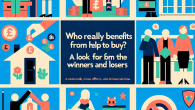
How the Gig Economy Is Affecting Pension Planning for Young Brits
How Financial Policies Shape Everyday Consumer Rights
Let’s have a heart-to-wallet chat, shall we? You might think financial policies are dry documents locked away in D.C. vaults, but in truth, they’re influencing your favorite coffee shop’s prices, the APR on your credit card, and even your ability to rent a one-bedroom apartment. I’m Eleanor “Ellie” Cartwright, your friendly neighborhood watchdog with a legal degree and a passion for consumer advocacy. Today, we’re unpacking how these towering, often perplexing policies trickle down and tangle up in our daily financial lives.
What Exactly Are Financial Policies?
At their simplest, financial policies refer to the rules and regulations set by governments and financial institutions to manage a nation’s economy. Think interest rate control by the Federal Reserve, consumer protection legislation, or lending standards enforced by the CFPB (Consumer Financial Protection Bureau).
These policies are designed to regulate:
- Monetary supply and inflation
- Credit and lending practices
- Consumer financial protections
- Treasury operations, like taxation and spending
But here’s the kicker: while all this may sound cerebral and government-y, it ends up hitting us hardest at the checkout counter, the car lot, and even in the hours we work each week.
The Domino Effect: Government Decisions and Your Wallet
Okay, picture this: the Federal Reserve raises interest rates. What comes next? Banks hike up borrowing rates. So faraway policy becomes palpable pain if you’re carrying a credit card balance or hunting for a mortgage. Let’s explore a few of these policy-to-pocketbook connections more deeply.
1. Interest Rate Policies and Consumer Debt
The Federal Reserve uses the federal funds rate to either stimulate or cool down the economy. When rates go up, borrowing becomes more expensive. That means your credit card interest climbs, auto loans cost more, and business loans shrink, reducing job growth.
In short: rate hikes = tighter wallets.
On the flip side, low interest rates might make mortgages more affordable but can reduce returns on savings accounts and retirement funds. That’s particularly tough on retirees relying on income from savings.
2. Lending Regulation and Access to Credit
Remember the 2008 financial crisis? I do—I was elbow-deep in court filings and congressional hearings at the time. One of the root causes was lax oversight on lending, especially in the housing market. In response, stricter financial policies like the Dodd-Frank Act were enacted to protect consumers from predatory practices.
Today, those protections are what prevent you from being charged sky-high interest without clear disclosure… usually. But the policies keep evolving, and that evolution determines who qualifies for what type of loan, under which conditions, and with how much transparency.
3. Tax Policy and Disposable Income
Whether you’re a gig worker, small business owner, or traditional employee, tax policies influence how much money stays in your bank account. Payroll taxes, capital gains, earned income tax credits—all of it can swing your financial stability by hundreds or thousands of dollars per year.
Consumer tip: Stay up-to-date on tax credits and deductions you’re eligible for. Those policies change annually and can significantly affect your bottom line.
How Advocacy Turns Policy into Protection
Now that we’ve gutted the engine of financial regulations, let’s talk about who’s behind the wheel when it comes to protecting everyday folks like you and me. That’s where advocacy rears its mighty head.
Who’s Fighting for Your Financial Rights?
A slew of watchdog organizations, legal advocates, and nonprofit agencies work tirelessly to make financial systems fairer. Groups like:
- Consumer Financial Protection Bureau (CFPB)
- National Consumer Law Center (NCLC)
- Public Citizen and other grassroots organizations
They push for reforms such as clearer loan disclosures, caps on payday loan interest rates, and fair lending practices. Their work often informs the policies that wind up on Capitol Hill and—eventually—in your mortgage agreements or credit contracts.
Why You Should Pay Attention (Yes, You!)
Policies only evolve when people demand change. Think your voice doesn’t matter? It does. Consumer complaints logged with the CFPB—yes, even that annoying overdraft penalty you got—help regulators spot patterns of abuse and take action.
It’s like financial crowd-sourcing. And you’re part of the crowd.
Everyday Examples of Policy in Action
Let’s take these abstract concepts and bring them home with real-life scenarios that show how your rights—and risks—are framed by financial policymaking:
- Overdraft Fees: Thanks to advocacy and regulation, banks today must get your permission before enrolling you in overdraft protection. That alone can save consumers billions annually.
- Credit Score Access: The Fair Credit Reporting Act (FCRA) entitles you to one free credit report per year from each bureau. That’s an intentional protection we didn’t always have.
- Student Loan Forgiveness: Whether you’re cheering or cringing, the expansion of forgiveness policies is a direct result of public outcry and policy lobbying.
How to Stay Informed & Get Involved
Financial policies impact nearly every element of your life, but you don’t need a Ph.D. (or a decade in legal advocacy like me) to keep up. Here are a few ways to stay ahead of the curve:
- Sign up for alerts from CFPB
- Follow watchdog organizations on social media
- File complaints when you’re wronged—it flags bad behavior
- Speak to your representatives about financial fairness issues
If you don’t advocate for yourself, someone else will write your financial future—and likely in fine print.
The Bottom Line
Financial policies aren’t just economic tools—they’re frameworks that define what you can afford, how you’re treated by lenders, and whether financial freedom is truly within reach. As consumers, we don’t have to be passive recipients. Understanding and engaging with these policies is the first step toward empowerment.
Ready to go from “budget-bewildered” to “policy-savvy”? Keep your eyes open, your inbox signed up, and your voice ready. Because with knowledge, comes leverage—and with leverage, we build a better future for all consumers.
Want to learn more about our mission or get in touch with a real human? Visit our About Us or Contact page. I promise, we don’t bite.









Leave a Reply